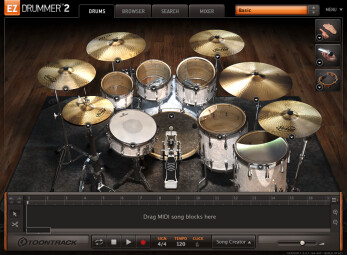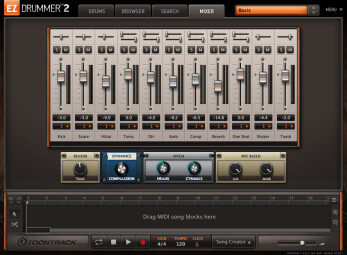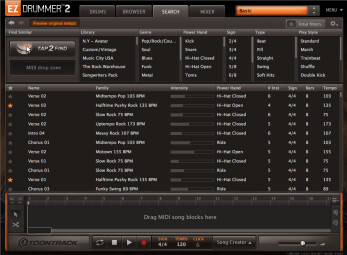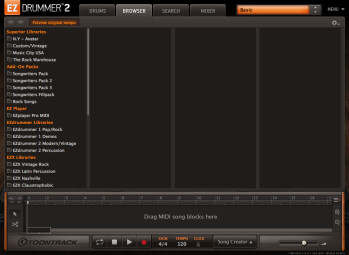Eight years after releasing the first EZdrummer, Toontrack introduces version 2, which gently revolutionizes the virtual drum market. Far from trying to grow in terms of gigabytes, EZdrummer bets on the usability of its interface and, especially, the intelligence of its functions. The result: A good lesson to all competitors
After having released Superior Drummer to compete with FXpansion’s BFD, Toontrack was the first to democratize the virtual drums concept with EZdrummer. Granted, EZdrummer doesn’t offer the detail nor the mixing possibilities of BFD or Superior, mainly due to its limited libraries (up to 1 GB, at best) and its reduced number of features. But, for half the price, it’s an excellent compromise: Much lighter and easier to use, it provides pre-mixed drums to musicians looking for a ready-to-use solution.
Many years have gone by and many excellent new libraries have come out. It must also be noted that EZdrummer hadn’t had a major update in eight years, giving competing brands time to organize themselves and offer, for more or less the same price, very pertinent alternatives for the most part, while Toontrack applied the EZ concept to multi-effects (EZmix) and pianos (EZkeys).
For these reasons, we were curious to discover this new EZdrummer 2, which ─ I’m going to say it even at the risk of ruining the suspense of this review ─ marks an evolution of the virtual drums concept that we hadn’t seen since, well, the first BFD. Yes. Nothing more and nothing less.
Evolution
Available in VST, AU, RTAS, and AAX formats in 32 and 64 bits for Mac and PC, EZdrummer 2 can also be used as a standalone program, just like its predecessor. People familiar with the first version won’t be thrown off by the software, which greets you with photo-realistic depictions of two drum kits: Modern and Vintage.
As always, each drum element is provided with a small arrow to access its editing options: Under the small contextual menu that opens up, you can replace a snare model with another one, but also define the pitch of the instrument and its volume, complementing what can be done in the Mixer section. Two new features have found their way there, as well: A sort of rectangular pad to hear the dynamic register of the instrument (Two new features have found their way there, as well: A sort of rectangular pad to hear the dynamic register of the instrument (depending on whether you click to the right or left of it, you can hear softer and louder velocities), and, especially, a menu that allows you to access elements of other EZX libraries. So, now it’s possible to use the Nashville hi-hats with the Twisted Kit bass drum and the snare of the Vintage Rock kit.
Besides this very nice evolution, there are also quite a few changes in the bottom part of the window, where the playback controls and time signature and tempo settings are. Toontrack added a zone similar to the one found on EZkeys: Just like on the latter, it will help you pre-build a drum track by adding your MIDI blocks there, before exporting the track to your sequencer with a simple drag-and-drop. You can obviously ignore this feature and drag your grooves directly into your sequencer, but this tool is much more interesting than it seems in first instance, as we will see later.
Another change that strikes you right away is the access to the different software sections. At the top of the GUI, there are now four tabs: Drums, which we just mentioned and is the software’s main interface; Browser, which, just like on the first EZdrummer, allows you to browse the folders and subfolders of your grooves collection (finally with a “Preview Original Tempo” button); Search, which provides a multi-criteria search engine to find the groove you need (and to which we will come back later. Oh, yes, we will!); and Mixer, which, as in the first EZdrummer, gives you access to a small mixing console.
In the mix
The mixing console retakes the same functions that it had in the first EZdrummer: Each mic or instrument has its own fader, plus a pan control and a Mute/Solo button, besides offering the possibility to easily route it to a particular audio channel. But Toontrack seems to have learned from the EZmix experience and now offers a nice little contextual effects section, like the one on EZkeys.
Depending on the chosen preset, you can access an effects chain ─ predefined by Toontrack ─, which can include a distortion, a compressor, an EQ, a flanger, a bitcrusher, a delay, etc.
Do note, however, that, even if you can adjust simple settings of the effects (the compressor has only one button, for example), it is not possible to change the effects nor their place in the chain. It’s not hard to imagine that this sort of advanced features will be a privilege reserved to Superior 3. Nevertheless, that doesn’t diminish in the least its addition to EZdrummer and we welcome the decision, since the effects are very good (they are the same as on EZmix, conceived mainly by the talented developers at Overloud) and they offer quite a few possibilities for a simple drum kit, without the software becoming unnecessarily complicated.
Thus, the two new kits offered with EZdrummer 2 alone have 30 presets, each one more interesting than the other, especially as you can modify this or that effect to increase its impact on the overall mix of the kit.
Here are some samples stemming from a single MIDI groove:

- Oldies Rock Basic 00:23
- Oldies Rock Dirty Rock 00:24
- Oldies Rock Glam Delay 00:24
- Oldies Rock Heavy Compressed 00:24
- Oldies Rock Old School Plate 00:24
- Oldies Rock Phased Bitcrusher 00:23
- Pushy Rock Disco Pop 00:15
- Pushy Rock Metal 00:16
- Pushy Rock Room 00:16
- Pushy Rock 80s 00:16
- Pushy Rock Basic 00:16
As you can hear, they don’t lack diversity or quality, while the good old Pop/Rock kit from EZdrummer 1 does show some signs of age, despite its lightness. For their part, the two new kits, Modern and Vintage, were recorded with top quality gear (REDD 5.1 console, Neve 88R, EMI TG12345) at the British Grove Studios and also feature a new proprietary technology called MHE, which stands for Multiple Hits Emulation. It’s hard to have any details about the latter, but we must admit that despite their relatively small sizes (1.76 GB for the Modern and 971 MB for the Vintage, which has less elements), the two kits come off pretty good.
Both kits can only be played with drumsticks and nothing seems to imply that Toontrack is interested in offering swishing brushes, as XLN Audio has, with varying success.
To close this chapter, Toontrack also improved the loading speed of the libraries, regardless of whether they are old or new, which is much appreciated.
However praiseworthy all these efforts, the sounds and the effects section might be, it wasn’t these innovations that caught our attention, but rather the famous Search tab, which we will introduce to you right away.
Seek and enjoy
Compared to the good old Groove browser, which hasn’t changed, the Search tab allows you to search your MIDI file collection according to different criteria. Thus, you have the possibility to filter grooves according to the library they belong to (EZX machine, EZX whatever, etc.), the musical genre (Pop, Funk, Country, etc.), the time signature, the playing style (Shuffle, Double Kick, Percussion), their type (Beat, Fill, Intro, Ending, etc.), and their “Power Hand, ” which means the groove’s most predominant instrument (like the hi-hat, snare, toms, etc.).
While you can obviously combine all these filters, organized in columns, you can also combine several values within the same column. Depending on whether you right or left click on the values, these may be including or excluding, In plain English, it means that you can do searches like: Show me all bluesy or funky MIDI grooves in any style, except Shuffle in 12/8 and 3/4, where the hi-hat is the main element. Alone for this, the progress from the first EZdrummer is evident, and also because the results include lots of information. Besides the style, type, signature and tempo info, there’s also an intensity indicator, so you know what kind of rhythm you will be dealing with. The higher the intensity, the denser the pattern (the drummer just can keep still), while the lower it is, the more minimalist (think Meg White on Tranxene, and on time). Another practical thing is that you can “bookmark” your favorite grooves with a star to easily find them afterwards. In my opinion, its only small defect is the impossibility to define your own personal tags or to add a text comment to a pattern and then be able to do a text search to make us of the filter. We hope that the Toontrack team will have it in its heart to deal with this shortcoming, which shouldn’t be too hard to fix.
That’s all very nice, you’ll say, but nothing extraordinary: Loads of virtual instruments, and even most sequencers, offer such filters to organize media and presets. That’s true, all right. But I still haven’t mentioned the killer feature in EZdrummer 2 that, in my opinion, puts all competitors in their place. The…
TAP 2 FIND
When you write a song, you usually have an idea, as vague as it might be, of the drum groove that you would like to have as foundation, a boom-chuck that you try to beatbox to the drummer in rehearsal or that you try to clumsily program with the piano roll of your sequencer, depending on whether you play alone or in a band. When he was composing Billie Jean, Michael Jackson started out as a human beatbox recording himself spontaneously, for instance. Yet, the problem is that no virtual drums had ever taken that into account.
You might have loads of grooves, each one better than the other one (and even more so when you add to them the Loop Loft or Groove Monkee collections), but regardless of how expensive and professional they are, you irremediably end up blind fishing whenever yo want to find that pattern you have in your head: You have to listen one by one to files very aptly named Groove1, Groove2, Groove3, Groove4, etc. in a depressing “Browser” interface. It’s like trying to find a needle in a haystack while blindfolded and handcuffed.
And thats’ where Toontrack’s Tap 2 Find feature comes in ─ incidentally, a function I’ve been bugging my friends with for years, so you can imagine the orgasm I had when I learned a software had implemented it.
Let me explain to you how it works: By pressing the Tap 2 Find button on the Search tab, you access a kit view. The metronome of the software is launched to the tempo and the signature defined in the software, only awaiting for you to enter the rhythm that you have in your head, By clicking on the different elements of the drum kit, or using a MIDI keyboard, you can input your famous boom-chuck, element by element, knowing that it records in loop mode and that with every new pass, your hits are quantized to an adjustable value (1/8, 1/16 or 1/32, in triplets or not). As soon as the groove sounds like the one you have in mind, you only need to click on “Show Results” to find a list of patterns classified by their resemblance to the groove you just input. Obviously, this list includes all infos previously mentioned and you can even refine your search with filters.
Simple as that!
It’s only that ─ but it’s a real game-changer in terms of usability and workflow, because you can start with a vague rhythm or even an external MIDI file that you can drop in the Tap 2 Find Drop Zone and go uber-intuitively to a vast array of ready-to-use patterns played by real drummers, with all those small delays and variations that make a drum part groove and sound more realistic. And you can obviously recall the Tap 2 Find function with a simple right-click on any groove of the software.
In fact, the only criticism I would make ─ and it’s a major one ─ is that it only works with Toontrack MIDI patterns. And what does that mean? Well, it means that even if any MIDI file can serve as the basis for a search, regardless of where it comes from, Tap 2 Find will only show results stemming from the publisher’s own libraries.
Questioned about this regrettable limitation, Toontrack neither confirmed nor denied that this functionality wouldn’t be extended to third-party libraries. So, we’ll have to wait and see how things unfold in this respect. Nevertheless, besides all grooves included in each EZX library, the publisher also offers a broad range of MIDI file packs, covering most genres and time signatures, which ought to add up to several thousand grooves.
And don’t underestimate the capacity of third-party publishers to offer libraries that might be compatible with the system. In any case, we will keep our fingers crossed hoping that it develops in the right direction.
Anyway, even when Tap 2 Find is limited only to Toontrack grooves for the time being, this EZdrummer 2 greatly simplifies the life of humble songwriters. And that’s even more true considering that, besides this search function, the software offers other excellent tools to sophisticate everything a bit more.
The multiplying of grooves
Let’s assume that you have found your dream pattern, thanks to Tap 2 Find. You can now drop it into your sequencer and have fun putting your drum part together with the piano roll or the Drum Edit of the latter, like in the old days. Or you can use the mini sequencer built into EZdrummer 2, which opens up new perspectives. Besides the classic Cut, Copy and Paste options, you also have the possibility to edit the playing style for each block (Edit Play Style, accessible right-clicking the block).
In this mode, you once again have the graphical representation of your kit, with the exception of the instruments that aren’t used by the MIDI file, which are grayed out. In addition to the bass drum and snare, you’ll see two black bubbles indicating the “Power Hand” (the element most used, which will often be the hi-hat or the ride) and the Opening Hit (the element that keeps on resonating, usually a Crash, Splash or China cymbal). Where it gets interesting is that you have the possibility to assign the Power Hand or the Opening Hit to another element of the drum kit with a simple drag-and-drop. This allows you to replace the hi-hat part with the one played on the floor tom, for instance. Just imagine the number of variations you can have from one single groove with this system…and that’s not all!
For every element used by the groove, you have a Velocity knob to determine whether it should be hit softer or harder (it’s not volume, but rather velocity), while an Amount knob allows you to increase or decrease the number of hits on the instrument. This allows you to define whether the hi-hat should play 4, 8 or 16 hits per bar. And that applies to each single element: Kick, snare, etc.
Interesting, isn’t it? But that’s still not all, because you also have additional percussion elements besides each kit: Clap, shaker and tambourine. These elements are also adjustable with the Velocity and Amount knobs. In short, combining all these tools you can create lots of variations from one single pattern, which can be used to make a variant of a verse, a break or a chorus. And guess what? That’s not all, because you can also combine the patterns between them.
Imagine that you find a pattern A whose snare and drum-kit relation is perfect, to the point that you placed it in EZdrummer’s internal sequencer. Now imagine that you find a nice hi-hat part in pattern B. Well, it’s my pleasure to inform you that right-clicking pattern B and selecting copy you can paste only the hi-hat into pattern A (by right-clicking on it) to replace the old one. Hurray! Three times hurray! My only regret is that there is no velocity filter, like on Addictive Drums: On the latter, you have two small faders to remove all hits below or above a given velocity, which is very practical to produce variations from a MIDI file.
But hurray anyway! And even more hurray, because there’s still one major part to review, namely the…
Song creator
Thanks to its tags and Tap 2 Find features, EZdrummer 2 is able to establish strong links between the different MIDI patterns. Thus, it can deduce which intro goes better with which groove, which bridge goes well with which chorus and which fill is ideal for which pattern. Based on that, Toontrack created the Song Creator tool, which makes an automatic preselection of grooves to match a single groove. From a simple MIDI file, the software suggests a selection of six intros, six verses, six pre-chorus, six choruses, six bridges, six fills, and six outros. 41 suggestions from one single file!
And to thrill the laziest of the laziest, you even have a Songs menu that automatically organizes these different patterns according to the structure you define: 12 basic bars or AABA, ABAB, ABCABC, etc.
So, with just a couple of clicks you can have a complete and coherent drum part, which will certainly interest those who use virtual drums to put together playback tracks to work with their instrument.
Conclusion
If all you are looking for in a virtual drums software application is high-quality samples for drum replacement or to play with a MIDI drum kit, chances are that such brilliant features as Tap 2 Find, Edit Play Style or Song Creator will leave you cold. The purpose of EZdrummer, given its entry-level price, is not to compete with the major players, like Superior or BFD, in terms of sound. But when it comes to songwriting…
Say what you will about my enthusiasm, but from my point of view as a songwriter, this new EZdrummer version is a real game-changer that makes all competitors look really old, regardless of their name or price. It’s very simple: For me, they are the most interesting virtual drums that have come out ever since the first BFD did, more than ten years ago. And even though I have BFD 1, Eco, Addictive Drums, Native Instruments drums, Superior, and Jamstix, I must admit that I haven’t even touched them ever since I had the chance to work with EZdrummer 2. It’s not a matter of sound ─ Superior and BFD offer more detailed libraries than the ones included in EZdrummer 2 (although those of the latter have nothing to be ashamed of, far from it, actually) ─ it’s a matter of usability, simplicity and gaining time when looking for the right groove, fill, etc. Time gained to the benefit of more creative tasks, obviously. And that’s what’s most important for me, personally.
At the end of the day, when it comes to making music, the best tool is the one that allows you to translate the ideas in your head into audible results as fast and easily as possible. And within this context, Tap 2 Find and the other smart features of Toontrack’s software really hit the nail on the head. Up to the point that we expect to see similar interfaces from all competing brands soon, as well as from sequencers, while we wait for someone really clever to develop a Beatbox2Find, a Sing2Find or a Sing2Sequence (using Melodyne algorithms, for instance). After all, it’s 2014 and you can already dictate an e-mail into your phone. Why shouldn’t audio software be capable of such intuitive things?
In the meantime, Toontrack deserves a standing ovation for a fantastic accomplishment. And we won’t hide our impatience to see the arrival of Superior 3, which ─ unless competing brands are swift to react ─ will surely become the indisputable market leader when it comes to virtual drums.








